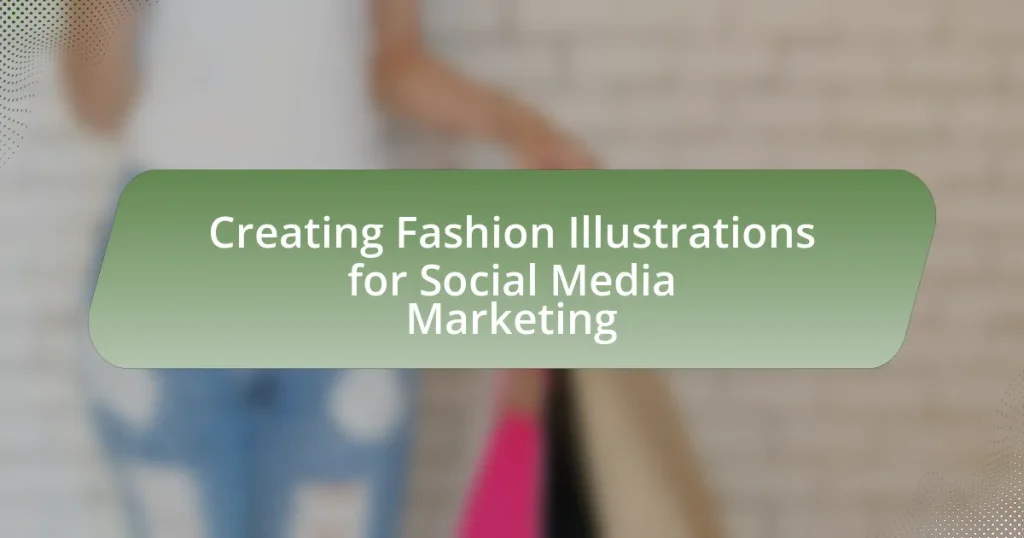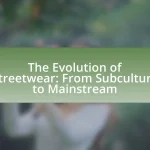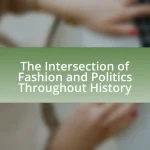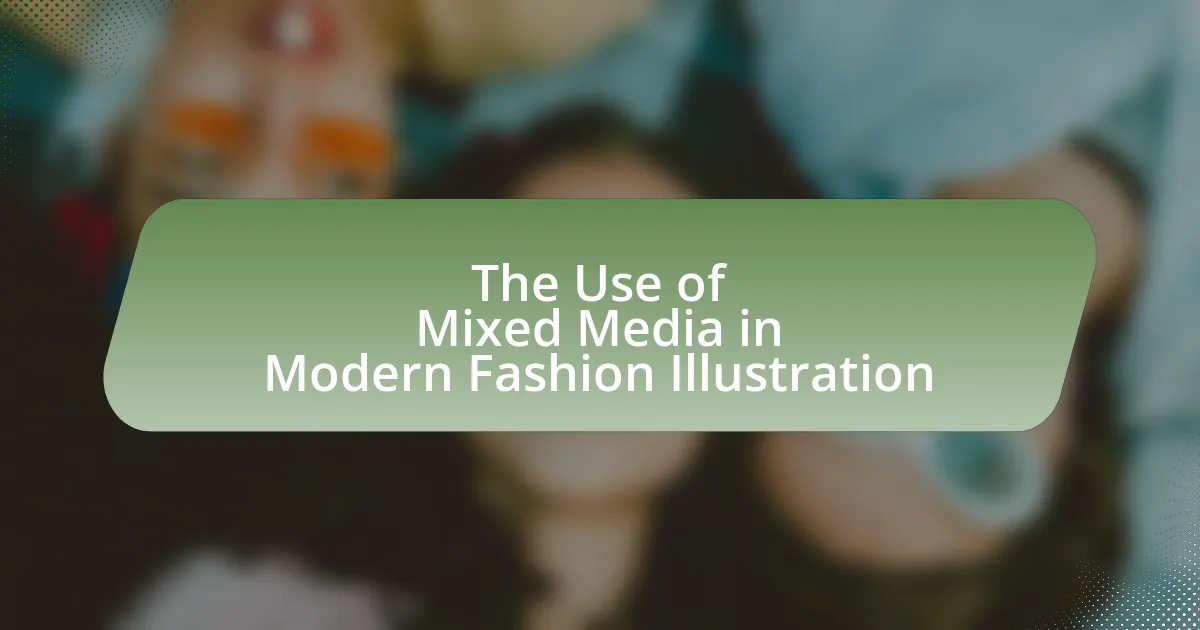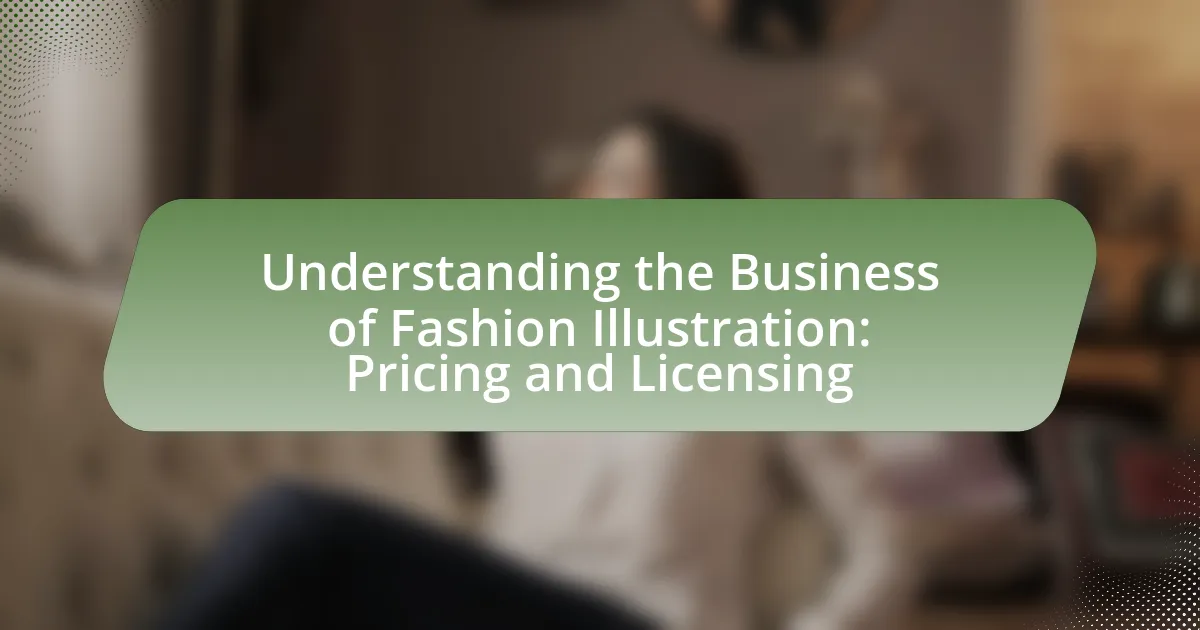Fashion illustrations are visual representations of clothing and accessories that play a significant role in social media marketing by enhancing brand identity and engaging audiences. This article explores how fashion illustrations can increase brand visibility, differentiate brands in a saturated market, and improve audience engagement through effective use of color, style, and digital techniques. It also discusses best practices for sharing illustrations on social media, the importance of maintaining consistency in illustration style, and strategies to encourage user-generated content. Additionally, the article addresses common challenges brands face in using fashion illustrations and offers solutions to overcome issues related to copyright and originality.
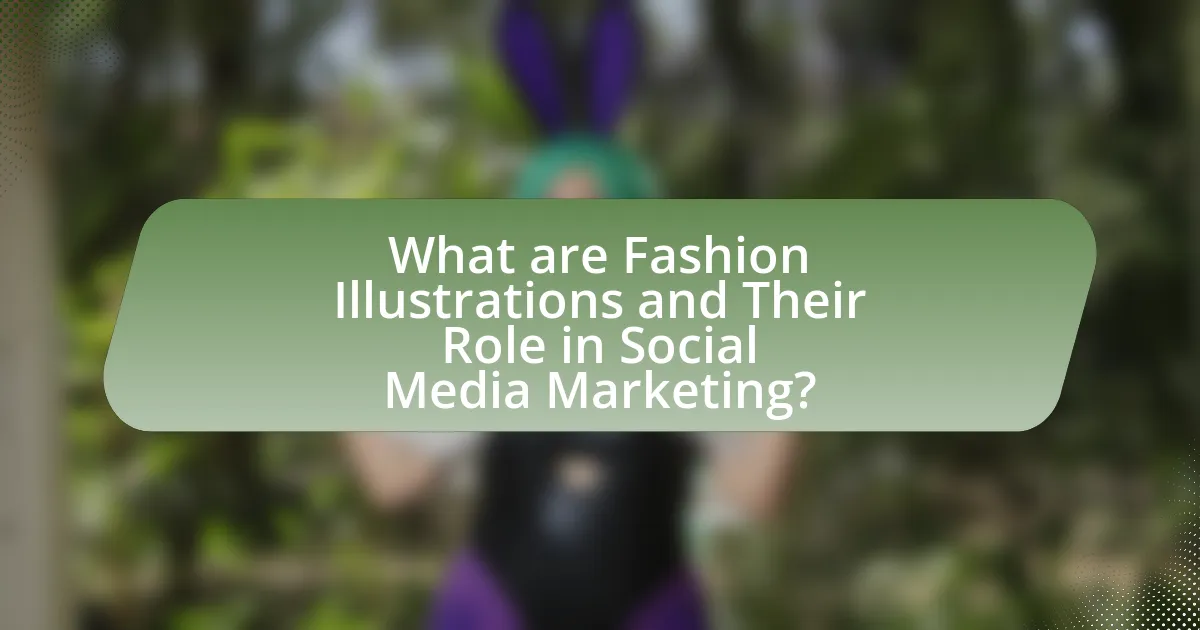
What are Fashion Illustrations and Their Role in Social Media Marketing?
Fashion illustrations are visual representations of clothing and accessories that convey style, design, and trends. In social media marketing, they play a crucial role by enhancing brand identity, engaging audiences, and showcasing products in a visually appealing manner. Research indicates that posts featuring illustrations can increase engagement rates by up to 50%, as they capture attention more effectively than standard photographs. This effectiveness stems from their ability to convey artistic expression and creativity, making brands more relatable and memorable to consumers.
How do Fashion Illustrations enhance brand visibility on social media?
Fashion illustrations enhance brand visibility on social media by providing visually engaging content that captures audience attention. These illustrations can convey a brand’s identity and aesthetic quickly, making them more shareable and likely to go viral. According to a study by HubSpot, visual content is 40 times more likely to be shared on social media than other types of content, highlighting the effectiveness of illustrations in increasing reach and engagement. Additionally, fashion illustrations can differentiate a brand in a saturated market, allowing it to stand out and attract a targeted audience.
What elements make a fashion illustration stand out in social media feeds?
Bold colors and unique styles make a fashion illustration stand out in social media feeds. Bold colors attract attention and evoke emotions, while unique styles showcase creativity and differentiate the illustration from others. Research indicates that visuals with vibrant colors can increase engagement rates by up to 80% on platforms like Instagram. Additionally, incorporating elements such as dynamic poses, intricate details, and relatable themes enhances viewer connection, making the illustration more memorable. These factors collectively contribute to higher visibility and interaction in crowded social media environments.
How do color and style choices impact audience engagement?
Color and style choices significantly impact audience engagement by influencing emotional responses and perceptions of brand identity. Research indicates that colors can evoke specific feelings; for instance, blue often conveys trust, while red can stimulate excitement. A study by the Institute for Color Research found that people make a subconscious judgment about a person, environment, or product within 90 seconds of initial viewing, with up to 90% of that assessment based on color alone. Additionally, style choices, such as typography and layout, contribute to the overall aesthetic appeal, which can enhance user experience and retention. For example, a clean, modern design can attract a younger audience, while a classic style may resonate more with an older demographic. Thus, effective color and style choices are crucial for maximizing audience engagement in fashion illustrations on social media.
Why are Fashion Illustrations important for fashion brands?
Fashion illustrations are important for fashion brands because they serve as a visual communication tool that conveys the brand’s identity and aesthetic. These illustrations help brands to showcase their designs in a creative and engaging manner, making it easier to capture the attention of potential customers. For instance, a study by the Fashion Institute of Technology found that visual content is 40 times more likely to be shared on social media than other types of content, highlighting the effectiveness of illustrations in marketing strategies. Additionally, fashion illustrations can simplify complex ideas, allowing brands to express their concepts and collections clearly, which is crucial in a visually-driven industry.
What advantages do fashion illustrations offer over traditional photography?
Fashion illustrations offer greater creative flexibility and artistic expression compared to traditional photography. Illustrations allow designers to convey imaginative concepts, styles, and colors that may not be achievable through photography due to limitations in real-life settings, lighting, or model poses. For instance, fashion illustrations can exaggerate proportions or incorporate fantastical elements, enabling a unique storytelling approach that resonates with audiences on social media. This artistic license can enhance brand identity and engage viewers more effectively, as seen in campaigns by brands like Gucci and Dior, which have utilized illustrations to create distinctive visual narratives that stand out in crowded digital spaces.
How can fashion illustrations convey brand identity effectively?
Fashion illustrations can convey brand identity effectively by visually representing the brand’s aesthetic, values, and target audience. These illustrations encapsulate the essence of a brand through color palettes, styles, and themes that resonate with its identity. For instance, a luxury fashion brand may use elegant, sophisticated illustrations with muted tones to reflect exclusivity, while a youthful streetwear brand might opt for vibrant colors and dynamic poses to appeal to a younger demographic. Research indicates that visual content is processed 60,000 times faster than text, making illustrations a powerful tool for immediate brand recognition and emotional connection. By aligning the illustration style with the brand’s narrative, companies can create a cohesive visual identity that enhances their presence on social media platforms.
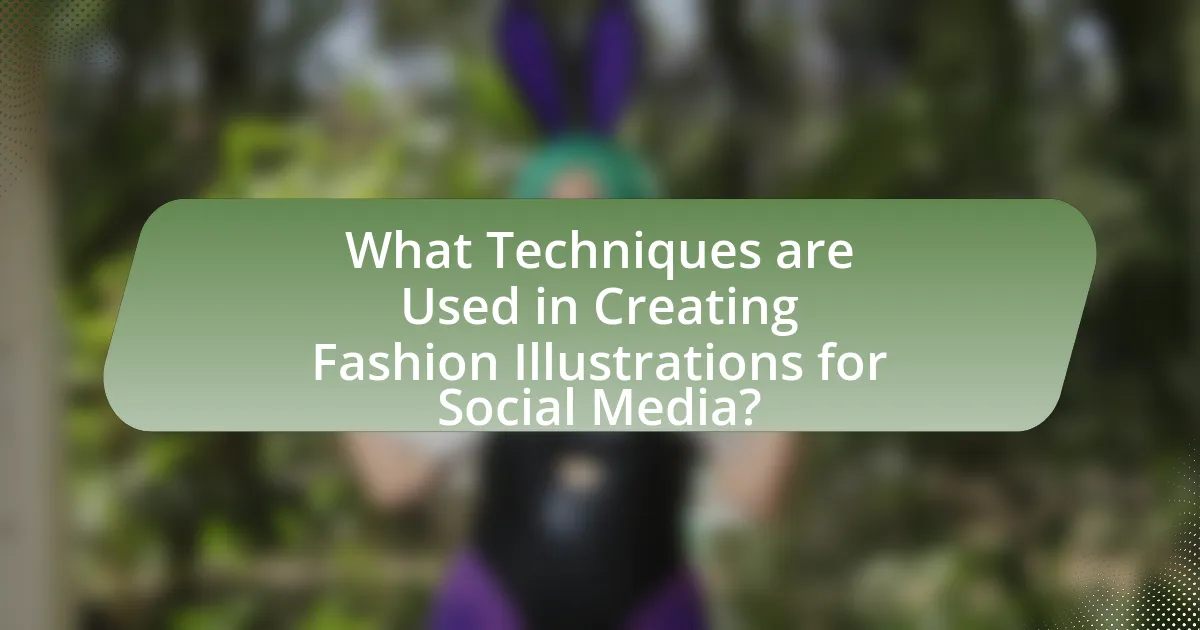
What Techniques are Used in Creating Fashion Illustrations for Social Media?
Techniques used in creating fashion illustrations for social media include digital illustration, mixed media, and vector graphics. Digital illustration allows artists to create detailed and vibrant images using software like Adobe Illustrator or Procreate, which are essential for high-quality visuals that engage audiences. Mixed media combines traditional drawing techniques with digital enhancements, providing a unique aesthetic that stands out on platforms like Instagram. Vector graphics are particularly useful for their scalability and clarity, ensuring that illustrations maintain quality across various screen sizes. These techniques are validated by their widespread adoption among fashion brands and influencers, who rely on visually appealing content to capture audience attention and drive engagement.
How can digital tools enhance the creation of fashion illustrations?
Digital tools enhance the creation of fashion illustrations by providing advanced features such as precision drawing, layering, and easy editing capabilities. These tools, like Adobe Illustrator and Procreate, allow illustrators to create detailed and vibrant designs quickly, facilitating a more efficient workflow. For instance, the use of vector graphics enables scalability without loss of quality, which is crucial for various social media formats. Additionally, digital tools often include a wide range of brushes and textures that can mimic traditional media, offering versatility in style. The integration of these technologies has been shown to increase productivity by up to 50%, allowing fashion illustrators to meet the fast-paced demands of social media marketing effectively.
What software and applications are most popular among fashion illustrators?
The most popular software and applications among fashion illustrators include Adobe Illustrator, Procreate, and CorelDRAW. Adobe Illustrator is widely used for its vector graphics capabilities, allowing illustrators to create scalable designs. Procreate is favored for its intuitive interface and powerful brush tools, making it ideal for digital sketching on iPads. CorelDRAW is also popular for its comprehensive design features and user-friendly layout. These applications are essential for creating high-quality illustrations that are often shared on social media platforms, enhancing marketing efforts in the fashion industry.
How do different digital techniques affect the final illustration quality?
Different digital techniques significantly impact the final illustration quality by influencing aspects such as color accuracy, detail resolution, and overall aesthetic appeal. For instance, techniques like vector graphics allow for scalable images without loss of quality, which is crucial for maintaining clarity across various social media platforms. Additionally, raster techniques can produce rich textures and gradients, enhancing visual depth but may suffer from pixelation if not managed properly. Studies have shown that illustrations created with high-resolution raster techniques can achieve a quality level that is 300 DPI or higher, which is optimal for print and digital displays. Furthermore, the use of digital brushes and layering techniques can add complexity and richness to illustrations, directly affecting viewer engagement and perception of professionalism in fashion marketing.
What traditional methods can be incorporated into fashion illustrations?
Traditional methods that can be incorporated into fashion illustrations include hand-drawing techniques, watercolor painting, and the use of charcoal or pastels. Hand-drawing allows for unique styles and personal expression, while watercolor painting adds depth and vibrancy to designs, a technique historically used by renowned fashion illustrators like David Downton. Charcoal and pastels provide texture and contrast, enhancing the visual appeal of illustrations. These methods not only connect to the rich history of fashion illustration but also resonate with audiences seeking authenticity in social media marketing.
How can hand-drawn elements add uniqueness to digital illustrations?
Hand-drawn elements add uniqueness to digital illustrations by infusing a personal touch and organic quality that digital tools often lack. This distinctiveness arises from the imperfections and variations inherent in hand-drawn art, which can evoke emotions and create a sense of authenticity. Research indicates that consumers are more likely to engage with content that feels genuine and relatable, as seen in a study by the Nielsen Norman Group, which found that users prefer designs that convey a human touch. Thus, incorporating hand-drawn elements can enhance the appeal of fashion illustrations in social media marketing, making them stand out in a saturated digital landscape.
What are the benefits of combining traditional and digital techniques?
Combining traditional and digital techniques in creating fashion illustrations enhances creativity and versatility. Traditional methods, such as sketching and painting, provide a tactile quality and unique artistic expression, while digital techniques offer precision, ease of editing, and the ability to quickly share and adapt designs for social media platforms. This hybrid approach allows artists to leverage the strengths of both mediums, resulting in illustrations that are visually appealing and effectively tailored for digital marketing. For instance, a study by the Fashion Institute of Technology found that illustrations combining hand-drawn elements with digital enhancements engage audiences more effectively on social media, leading to higher interaction rates.
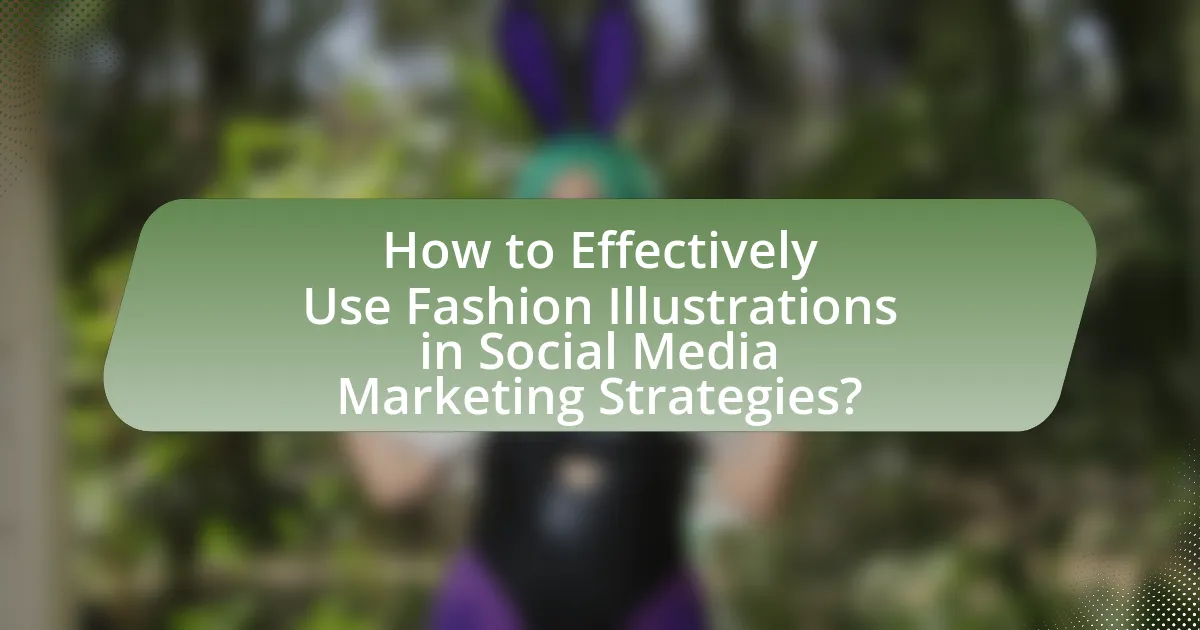
How to Effectively Use Fashion Illustrations in Social Media Marketing Strategies?
To effectively use fashion illustrations in social media marketing strategies, brands should integrate visually appealing and relevant illustrations that resonate with their target audience. Fashion illustrations can enhance brand storytelling, create a unique visual identity, and engage users through platforms like Instagram and Pinterest, where visual content thrives. Research indicates that posts with images receive 94% more views than those without, highlighting the importance of compelling visuals in capturing audience attention. Additionally, using fashion illustrations allows brands to showcase their creativity and differentiate themselves in a saturated market, ultimately driving higher engagement and conversion rates.
What are the best practices for sharing fashion illustrations on social media?
The best practices for sharing fashion illustrations on social media include using high-quality images, engaging captions, and relevant hashtags. High-quality images attract more viewers and showcase the details of the illustrations effectively. Engaging captions can provide context or tell a story, enhancing viewer connection. Relevant hashtags increase visibility and reach, allowing the illustrations to be discovered by a broader audience. According to a study by HubSpot, posts with images receive 94% more views than those without, underscoring the importance of visual quality in social media sharing.
How can timing and frequency of posts influence audience reach?
Timing and frequency of posts significantly influence audience reach by determining when and how often content is seen by potential viewers. Research indicates that posting during peak engagement times, such as evenings and weekends, can increase visibility, as users are more active on social media during these periods. Additionally, maintaining a consistent posting frequency helps keep the audience engaged and aware of the brand, leading to higher interaction rates. For instance, a study by Sprout Social found that brands posting at least once a day on platforms like Instagram see a 50% increase in engagement compared to those posting less frequently. This demonstrates that strategic timing and regular posting can effectively enhance audience reach in social media marketing.
What types of captions and hashtags work best with fashion illustrations?
Captions that evoke emotion, tell a story, or highlight the design process work best with fashion illustrations. Engaging captions can include personal anecdotes about the inspiration behind the illustration or descriptions of the materials used, which resonate with the audience and enhance connection. Hashtags that are effective include specific fashion-related tags like #FashionIllustration, #FashionArt, and #IllustrationOfTheDay, as well as broader tags like #Fashion and #Art, which increase visibility. Research indicates that posts with at least one hashtag receive 12.6% more engagement than those without, demonstrating the importance of strategic hashtag use in social media marketing for fashion illustrations.
How can fashion illustrations be used to engage with followers?
Fashion illustrations can engage followers by visually conveying brand identity and storytelling. These illustrations capture attention through unique artistic styles, allowing brands to differentiate themselves in a crowded market. For instance, a study by the Fashion Institute of Technology found that visual content, including illustrations, increases engagement rates on social media platforms by up to 94%. This heightened engagement occurs as followers are drawn to the creativity and aesthetic appeal of illustrations, prompting shares, comments, and likes, which further amplify brand visibility.
What interactive elements can be added to fashion illustrations for better engagement?
Interactive elements that can be added to fashion illustrations for better engagement include clickable hotspots, animated features, and augmented reality (AR) integration. Clickable hotspots allow users to interact with specific parts of the illustration, providing additional information or links to products. Animated features can bring illustrations to life, capturing attention and encouraging shares on social media platforms. Augmented reality integration enables users to visualize how clothing items would look on them in real-time, enhancing the shopping experience. These elements have been shown to increase user interaction and retention, as studies indicate that interactive content can lead to a 2-3 times higher engagement rate compared to static content.
How can brands encourage user-generated content through fashion illustrations?
Brands can encourage user-generated content through fashion illustrations by creating engaging campaigns that invite customers to share their own illustrations inspired by the brand’s designs. For instance, brands can host contests or challenges on social media platforms, where participants submit their fashion illustrations for a chance to be featured or win prizes. This approach not only fosters creativity but also builds a community around the brand, as seen in successful campaigns by companies like Adidas and Nike, which have effectively utilized user-generated content to enhance brand loyalty and visibility. By providing clear guidelines and showcasing user submissions, brands can further motivate their audience to participate, leading to a diverse array of illustrations that reflect the brand’s aesthetic and values.
What are some common challenges in using fashion illustrations for social media marketing?
Common challenges in using fashion illustrations for social media marketing include ensuring visual appeal, maintaining brand consistency, and adapting to platform specifications. Visual appeal is crucial as illustrations must capture attention in a crowded digital space; studies show that posts with high-quality visuals receive 94% more views. Brand consistency is essential to reinforce identity, as inconsistent styles can confuse audiences and dilute brand messaging. Additionally, adapting illustrations to fit various platform specifications, such as image size and format, can complicate the design process, leading to potential loss of quality or impact.
How can brands overcome issues related to copyright and originality?
Brands can overcome issues related to copyright and originality by implementing a robust strategy that includes creating original content, obtaining licenses for existing works, and utilizing public domain resources. By focusing on original content, brands can ensure that their illustrations are unique and not infringing on others’ copyrights. Additionally, acquiring licenses for existing works allows brands to legally use copyrighted material while respecting the rights of the original creators. Utilizing public domain resources, which are free from copyright restrictions, provides brands with a wealth of material that can be adapted and used without legal concerns. This approach not only mitigates the risk of copyright infringement but also fosters creativity and innovation in fashion illustrations for social media marketing.
What strategies can be employed to maintain consistency in illustration style?
To maintain consistency in illustration style, artists should establish a clear style guide that defines color palettes, line weights, and character proportions. This guide serves as a reference point, ensuring that all illustrations adhere to the same visual language. Additionally, regular practice and creating templates can help reinforce the chosen style, making it easier to replicate across different projects. Research indicates that visual consistency enhances brand recognition, with studies showing that consistent branding can increase customer loyalty by up to 23%.
What tips can help improve the effectiveness of fashion illustrations in marketing?
To improve the effectiveness of fashion illustrations in marketing, focus on creating visually striking and relevant designs that resonate with the target audience. Utilizing color psychology can enhance emotional engagement; for instance, studies show that colors can influence purchasing decisions, with 85% of consumers citing color as a primary reason for their purchase. Additionally, incorporating storytelling elements into illustrations can create a narrative that connects with viewers, making the brand more relatable. Research indicates that visuals paired with storytelling can increase engagement rates by up to 300%. Lastly, optimizing illustrations for various social media platforms ensures that they are tailored to the specific audience and format, which can significantly boost visibility and interaction.
